新人教版七年级英语下册Unit3 教案
七年级英语下册unit3教案课堂教学设计

本文将分享一份关于七年级英语下册Unit 3的课堂教学设计。
这一单元的主题是“Excuse me, where’s the post office?”,旨在帮助学生学会寻问和指示方向。
一、教学目标1.学生能够利用“Excuse me, where’s…?”和“Go straight / Turn left /Turn right / Do a U-turn…”等相关表达方式寻问和指示方向。
2.学生能够掌握交通工具和要素的相关单词和短语,如bus stop, subway, trainstation, etc.3.学生能够在交流中理解和使用地图和城市布局相关的词汇。
二、教学准备1.PowerPoint演示文稿2.学习用的绘画和游戏材料3.相关练习题和课堂活动材料三、教学步骤1.导入引入问题:幻灯片上展示一张城市地图,要求学生根据已知的地标(如学校、体育场、购物中心等)找出周围的其他地方。
2.学习交通工具和要素教师通过幻灯片展示不同的交通工具和点。
继续讨论如何利用不同的交通工具到达一个点,例如,利用地铁从学校到达电影院:Excuse me, how do I get to the movie theater?Take the subway.Where's the subway?Turn right and go straight. The station is on your left.3.教学寻问和指示方向教师在幻灯片上展示不同地理位置的照片和地图,提示学生开始学习如何问路和指路。
教师向学生展示如何使用“Excuse me, where’s…?”句型,以及“Go straight / Turn left / Turn right / Do a U-turn…”等表达方式来指示方向。
教师可以与学生分组进行角色扮演,以加强他们的语言进程和提高他们的口语表达能力。
4.练习方向、地图和城市布局相关的词汇通过游戏、图片和绘画等多种形式收集和展示不同的地图和城市布局相关的单词和短语,例如:Bus stop / Subway / Train stationNorth / South / East / WestOn the left / On the right / Across the street / Next to5.面向现实场景的实践通过现实场景的练习加强学生的学习效果。
初一七年级英语下册人教版Unit 3 How do you get to school? 单元教案、教学设计
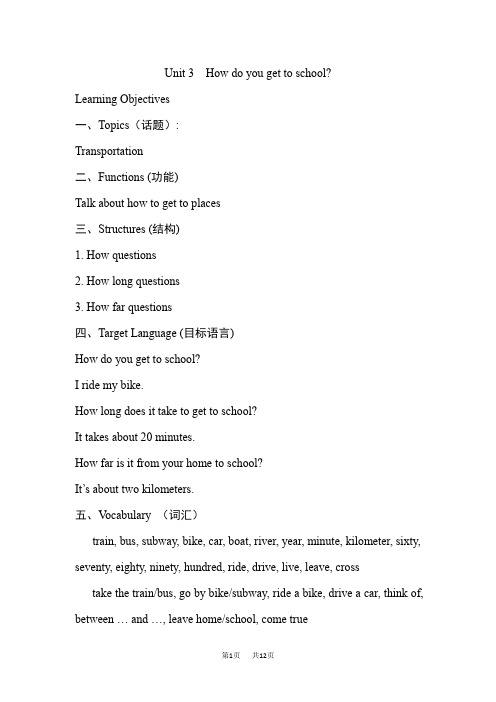
Unit 3 How do you get to school?Learning Objectives一、Topics(话题):Transportation二、Functions (功能)Talk about how to get to places三、Structures (结构)1. How questions2. How long questions3. How far questions四、Target Language (目标语言)How do you get to school?I ride my bike.How long does it take to get to school?It takes about 20 minutes.How far is it from your home to school?It’s about two kilometers.五、V ocabulary (词汇)train, bus, subway, bike, car, boat, river, year, minute, kilometer, sixty, seventy, eighty, ninety, hundred, ride, drive, live, leave, cross take the train/bus, go by bike/subway, ride a bike, drive a car, think of, between … and …, leave home/school, come true六、Skills (技能)Listening for key informationScanning in reading七、Recycling (复习巩固)Numbers 1–30I usually …It is easy to …Thanks for …八、教材分析本单元以How do you get to school?为中心话题,主要运用How long/How far 询问“去某地的交通方式、时间、距离”,简单描述路线。
七年级英语下人教版 Unit3 教案四
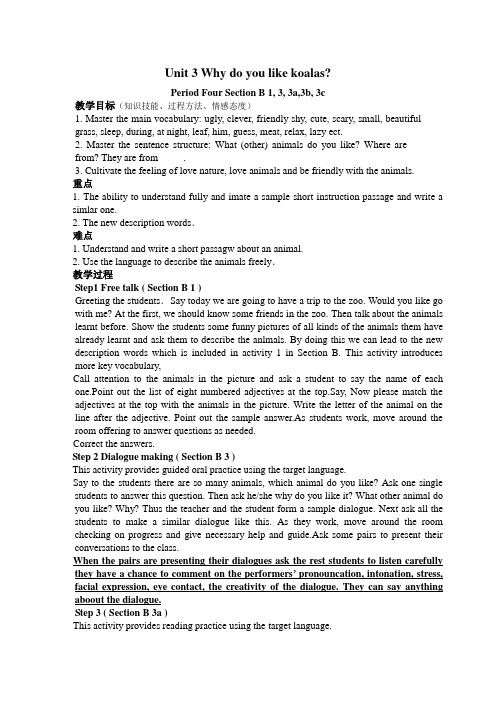
Unit 3 Why do you like koalas?Period Four Section B 1, 3, 3a,3b, 3c教学目标(知识技能、过程方法、情感态度)1. Master the main vocabulary: ugly, clever, friendly shy, cute, scary, small, beautiful grass, sleep, during, at night, leaf, him, guess, meat, relax, lazy ect.2. Master the sentence structure: What (other) animals do you like? Where are __ from? They are from_____.3. Cultivate the feeling of love nature, love animals and be friendly with the animals.重点1.The ability to understand fully and imate a sample short instruction passage and write a simlar one.2.The new description words.难点1.Understand and write a short passagw about an animal.2. Use the language to describe the animals freely.教学过程Step1Free talk ( Section B 1 )Greeting the students.Say today we are going to have a trip to the zoo. Would you like go with me? At the first, we should know some friends in the zoo. Then talk about the animals learnt before. Show the students some funny pictures of all kinds of the animals them have already learnt and ask them to describe the anlmals. By doing this we can lead to the new description words which is included in activity 1 in Section B. This activity introduces more key vocabulary,Call attention to the animals in the picture and ask a student to say the name of each one.Point out the list of eight numbered adjectives at the top.Say, Now please match the adjectives at the top with the animals in the picture. Write the letter of the animal on the line after the adjective. Point out the sample answer.As students work, move around the room offering to answer questions as needed.Correct the answers.Step 2 Dialogue making ( Section B 3 )This activity provides guided oral practice using the target language.Say to the students there are so many animals, which animal do you like? Ask one single students to answer this question. Then ask he/she why do you like it? What other animal do you like? Why? Thus the teacher and the student form a sample dialogue. Next ask all the students to make a similar dialogue like this. As they work, move around the room checking on progress and give necessary help and guide.Ask some pairs to present their conversations to the class.When the pairs are presenting their dialogues ask the rest students to listen carefully they have a chance to comment on the performers’ pronouncation, intonation, stress, facial expression, eye contact, the creativity of the dialogue. They can say anything aboout the dialogue.Step 3 ( Section B 3a )This activity provides reading practice using the target language.Show a picture of the leader of the zoo. And say to the students that the leader come across with some difficulties, can you help him? Then lead to “ Let’s help. (1)”. Say that the three animal instrctions and the animal names are in wrong order because of the heavy rain. Can you help putting them in right order? Then ask the students to resd the three instruction by themsekves and match the instruction with the animals.Check the answers.Say in order to let the visitors fully understand the three animals, let’s make a table to compare the three animals. But the table haven't finished would you please finish it?Give the students some minutes to finish the table then check the answers.Step 4 ( Section B 3b )This activity introduces some new vocabulary words and provides reading and writing practice using the target vocabulary.Say the instruction of the lions is destoried by the heavy rain. Would you please help filling the blanks of the instruction so that the other visitors could know the lions more.Call attention to the pictures of animals in 3a, and draw attention to the grass, leaves, and meat. Ask a student to explain each word or use it in a sentence to show he or she understands what it means. Teach the expression sleeps.Point out the description in 3b with blank lines where some words are missing. Read it to the class saying blank each time you come to a blank line.Point out the six words in the box. Say, You can write these words in the blanks. Use each word only once.As students work, move around the room checking progress and offering language support as needed.Check the answers.Step 5 ( Section B 3c )This activity provides reading and writing practice using the target language.Say the leader of the zoo have another problem. The zoo decided to bring in a new kind of animal that is penguins. But the instruction haven’t been written. Would you please help writing a instruction of the penguins for the zoo. The main features of the penguins are on the screen for you. Then give the students several minutes to write the short passage. While the students are writing, move around the classroom and give necessary help. Ask students to share their writing with others in the class. The other students should comment on the short passage written by one specific student. They can comment on the grammar, the vocabulary, and the structure of the short passage.Step 6 ( Words from the leader )Say the animal are so lovely, right? But ther are some ones always want to hurt the lovely animals in order to make money. Then show the students a picture of a dead elephant whose teeth are taken by someone. Is it brutal? So out leader have words for you. Let’s love animals and be friends with them and love nature. Wuold like to do it?Step 7 ( Homework )1. Finish the exercise book part 5 and 6.2. Copy the new words on page 16 and 17 three times and remember them by heart.3. Find some proverbs concering the animals.。
新人教版七年级英语下册Unit3 教案
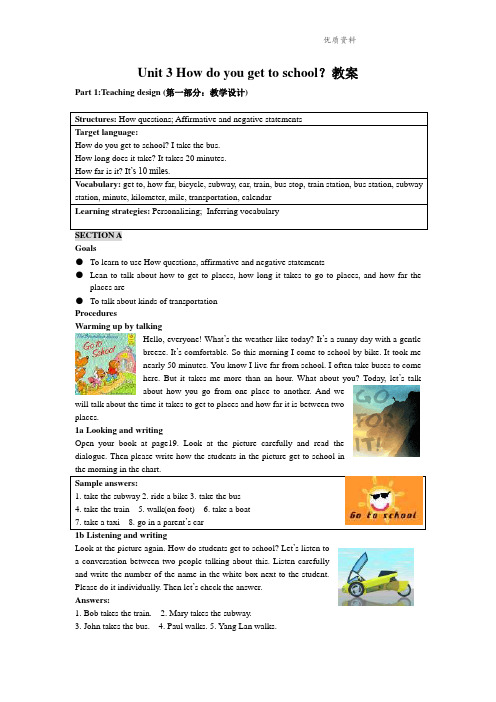
Unit 3 How do you get to school?教案Part 1:Teaching design (第一部分:教学设计)Structures: How questions; Affirmative and negative statementsTarget language:How do you get to school? I take the bus.How long does it take? It takes 20 minutes.How far is it? I t’s 10 miles.Vocabulary: get to, how far, bicycle, subway, car, train, bus stop, train station, bus station, subway station, minute, kilometer, mile, transportation, calendarLearning strategies: Personalizing; I nferring vocabularySECTION AGoals●To learn to use How questions, affirmative and negative statements●Lean to talk about how to get to places, how long it takes to go to places, and how far theplaces are●To talk about kinds of transportationProceduresWarming up by talkingHello, everyone! What’s the weather like today? It’s a sunny day with a gentlebreeze. It’s comfortable. So this morning I come to school by bike. It took menearly 50 minutes. You know I live far from school. I often take buses to comehere. But it takes me more than an hour. What about you? Today, let’s talkabout how you go from one place to another. And wewill talk about the time it takes to get to places and how far it is between twoplaces.1a Looking and writingOpen your book at page19. Look at the picture carefully and read thedialogue. Then please write how the students in the picture get to school inSample answers:1. take the subway2. ride a bike3. take the bus4. take the train5. walk(on foot)6. take a boat7. take a taxi 8. go in a parent’s car1b Listening and writingLook at the picture again. How do students get to school? Let’s listen toa conversation between two people talking about this. Listen carefullyand write the number of the name in the white box next to the student.Please do it individually. Then let’s check the answer.Answers:1. Bob takes the train.2. Mary takes the subway.3. John takes the bus.4. Paul walks.5. Yang Lan walks.TapescriptA: How do Bob and Mary get to school?B: Bob takes the train and Mary takes the subway.A: How does John get to school?B: He takes the bus.A: How do Paul and Yang Lan get to school?B: They walk. Look, there they are waling now!Now read the tapescript, shadow the how questions and underling the expressions.1c Doing pairworkPlease read the dialogue on page 19 in the box. And make your own conversations about how the’ll ask some pairs to say their dialogue. Sample dialogueA: How does Bob get to school?B: He takes the train.A: Does John take the train to school, too?B: No. He takes the bus.A: What aboutMary and Paul?B: Paul walks,and Mary takes thesubway.A: And Yang Lan walks, does she?B: Yes, she does.2a Listening and repeatingListen to these numbers and repeat. Please pay attention to the pronunciation.Tapescript32, 40, 50, 60, 70, 80, 90, 100forty-six 46 thirty-three 33 seventy-two 72one hundred and five 105 fifty-eight 58 ninety-nine 99sixty-one 61 eighty-four 84Now please look at the five transportation pictures. And we’ll listen to two conversations. The people are talking about how students get to school and how long it takes. Listen carefully and put a checkmark to show the kinds of transportation they talk about. Check your answer.40 minutes 35minutes25minutes10 minutesListen carefully again and match the time with the kinds ofTapescriptConversation 1Boy: How do you get to school?Girl: I take the train.Boy: How long does it take?Girl: Oh, around forty minutes. How aboutyou?Boy: I take the subway.Girl: How long does that take?Oh, around thirty-five minutes.Conversation 2Girl: How do you get to school, Tom?Tom: I ride my bike.Girl: How long does it take?Tom: It takes around twenty-five minutes.Tom: How do you get to school?Girl: I walk.Tom: And how long does that take?Girl: It only takes ten minutes.Look at the sentences on the board. “They take the train. It takes about forty minutes.”“Take the train” means to ride the train. And we also use “take” to talk about a length of time. For example, it takes me 20minutes to get to school. So we use the same word, take, in two different ways. Now read the tapescript, shadow the how questions and underling the expressions.2d Doing pairworkNow please make your own conversations about how you get to school and how long it takes.Example:A: How do you get to school?B: well, I usually walk but sometimes I take the bus.A: How long does it take?B: It takes about 25 minutes to walk and 10 minutes by bus. What about you? A: I get to school by bike, sometimes I take my father’s car.B: Oh, how long does it take?A: It takes around 40 minutes by bike and 15 minutes by car.3a Reading and writingSo far you have learned to talk about how you get to school and how long it takes.The passage you will learn in this part tells us something about Li Lei. Pleaseread the questions about Li Lei in the speech bubbles. Then read the passage andwrite the answers to the questions on the line. You should complete the activityindividually.1How does he 2 How long does 3 How far is it fromget to school? it take? his home to school?By bike and It usually takes About 10 kilometers.by bus. about 35 minutes.Now read the passage following the tape sentence by sentence. Please pay attention to the pronunciation and intonation of the native readers and try to imitate them. Then draw lines under the useful phrases and structures.Lin Fei’s home/ is about 10 kilometers /from school. He gets up /at six o’clock/ every day, showers, and has a quick breakfast. Then/ he leaves for school/ at around six-thirty. First, he rides his bicycle/ to the bus station. That takes about ten minutes. Then/ the early bus/ takes him to school. The bus ride/ usually/ takes about 25 minutes.school? What time do you get up? How do you get to school? Let’s ask some students to say something about you.3b Doing pairworkLook at the pictures on page 21. Can you name each form of transportation? They are easy to you. Read the time and distance that goes with each form of transportation. Pay attention to “mile”, which is a common measure of distance in some western countries. (1 mile=1.6 kilometers). Read the example dialogue in the box.A: How do you get to school?B: I take the train.A: How far is it from your home to school?B: It’s eight miles.A: How long does it take you to get from home toSchool ?B: It takes 35 minutes.A: How do you get to school?B: I walk.A: How far is it from your home to school?B: It’s two miles.A: How long does it take you to get from home to school ?B: It takes 40 minutes.A: How do you get to school?B: I take the bus.A: How far is it from your home to school?B: It’s four miles.A: How long does it take you to get from home to school?B: It takes 15 minutes.4 Talking and writingWell done everyone! Now let’s play a game: Info Gap Race! This time you work in groups of three. You decide which one is A, which one is B and which one is C. Please read the instruction. You ask each other questions to learn information for your chart, and then write the answers on the chart in your book. Don’t look at others’ pages please. The first group to fill in all the blanks is theWho How How long How far1. Maria bus twenty minutes five miles2. John bike ten minutes six miles3. Liu Pei subway fifteen minutes eight milesC:How does Maria get to school?A: She takes the bus. How long does it take Maria to get to school?B: It takes her twenty minutes. How far is it from her home to school?C:It’s five miles.Closing down by asking and answering(using the useful information learned in this part)*How do you get to school?*I usually walk, but sometimes I take the bus.*How long does it to take you to get from your home to school?*It takes 25 minutes.*How far is it from your home to school?*It’s around 4miles. A bus station Section BGoals●To learn to use: bus stop, train station, subway station●To learn to talk about how to get to places further.ProceduresWarming up by asking some individuals questionsHow does Li Lei get to school? First, he rides his bicycle to the bus station. Then he takes the early bus to school. Do you know the bus station? It’s a place where trains stop here. Today we’ll study some other “stations”.1a Looking and matchingLook at the four phrases on the top of page 22 and read them loudly. Then match the words withAnswers: 1. b bus stop 2. a train station 3. c bus station 4. d subway station1b Doing pairworkRead the dialogue in the box first. Then suppose you use two kinds of transportation to get to school. Now make your own dialogues to tell your partner how you get to school, using theSample dialogue:A: How do you get to school?B: Well, I ride my bike to the subway station. Then I take the subway. What about you?A: First, I walk to the bus stop. Then I take the bus to school.A: How does your father get to his school?B: Well, he walks for ten minutes to Bus No. 11. He takes the bus and gets off at Da Yingpan. Then he walks again for five minutes to his classroom.2a Listening and checkingOK, now. Let’s listen to the conversation between Tina and Thomas. What does Thomas want to know about Nina? Here is a list of information that Thomas wants to know. I’ll ask some students to read lines to the class. Then listen carefully and put a checkmark in front of each thing thatThomas wants to know…√where Nina lives.how far from school she lives.how long it takes Nina to get to school.√how she gets to school.what she thinks of the transportation.2b Listening and checkingLook at the pictures on page 22 with a blank line in front of each. They show the ways of how to get to school. Which one is Nina’s? Listen carefully and put a checkmark next to the picture that shows how Nina gets to school.1.—to ride a bike to the subway—to take the subway tothe bus—to walk from the bus stop to the school2.√to walk to the bus—to take the bus to the subway—totake another bus after the subway—to walk from the busTypescriptThomas: Where do you live, Nina?Nina: New Street.Thomas: So, how do you get to school?Nina: Well, first I walk to the bus stop.Thomas: Uh-huh.Nina: I take a bus to the subway station. Then I take the subway.Thomas: Yeah…Nina: Next I take a bus to the bus stop on 26thStreet. Finally I walk.You may turn to the tapescript to read it, underlining theexpressions and shadowing the how questions.2c Doing groupworkNow make your conversations about how Nina gets to school in groups of four. You can use the pictures in activity 2b. Pay more attention to the sentence starters: S he…; Next, she…; Then, she…Sample dialogue:A: How does Nina get to school?B: She walks to the bus stop.C: Next, she takes a bus to the subway station.D: Then she takes another bus to the bus stop on 26th street after the subway.A: Finally she walks to school.Now let’s ask some of you to say your descriptions to the class.3a Reading and writingNow you can say something about how you get to school.Do you want to know how students around the world get to school? Read the article on page 23, and then decide if the statements are true or false in your exercise book.Check the answers:T 1. In North America, not all students take the bus to school.T 2. Other parts of the world are different from the United States.F 3. In Japan, the three most popular ways of getting to school are bus, train and bike. (Students take trains, or walk, or ride bikes)F 4. In China, bikes and buses are the most popular means of transportation. (It depends on where you are)T 5. Students in Hongshanhu and Kaishandao have to take a boat to get to school.Read the article once again, this time, to slash/ the sentences, underline the useful expressions in it and shadow the connectives. After school, you are going to write them down in your notebook. How do students around the world get to school?In North America, most students/ go to school/ on the school bus. Somestudents/ also walk/ or ride bikes to school. In other parts of the world,things are different. In Japan, most students/ take trains to school,although others also walk/ or ride their bikes. In China, it depends on /where you are. In big cities, students usually ride bikes to school/ or take buses. And in places/ where there are rivers and lakes, like Hongshanhu and Kaishandao, students usually go to school/ by boat. That must be a lot more fun/ than taking a bus!3b Reading and writingLook at the chart. Then read the article and fill in the blanks. You can findthe answers in the chart. Please complete the activity individually.How do the students get to Garden High School?At Garden High School, most students ride their bikes to school. Many students walk. Some students drive. Other students take the bus. A small number of students take the subway.3c WritingJust now we filled in an article about how students get to Garden High School. What about you?How do students in our class get to school? Let’s make a survey and listyour ideas on the board. You can use the words and numbers to write apassage about how students in our class get to school.Sample passage:In my class, most students ride their bikes to school. Many students go to school on foot. Some students live far from school, so they go to school by bus. A few students take their parents' car to school.At Taiyuan Wuzhong, most students live at school. They just walk to their classroom. So they don’t ride their bikes to school. Many students play on the playground in the early morning. Some students play football. Some read aloud their English texts. But at the same time, other students in other schools have to take the bus, ride the bike, to hurry to their schools.4 Making a surveyNow turn to page 82, please. Look at the chart. Read the heading and the phrases listed below.Please complete the chart in ten minutes. You can go around the class and ask questions to find out the answers. Look at the dialogue in the box next to the chart. You can ask questions like this.Find someone who…Nameslives 10 miles away from school.walks to school.takes a bus to school.takes more than an hour to get to school.ride s a bike to school.takes the subway to school.takes less than ten minutes to get to school.Do you remember Nina? How does she get to school? How do students around the world get to school? Please tell me in your own words. And I will also ask some of you to say something about themselves. Who will be the first to have a try?SELF CHECKGoals●To revise the vocabulary introduced in the unit●To practice writing skillProcedures1 Filling the blanks and making sentencesLook at part 1 on page 24. Fill in the blanks with the words given to you. Change the form of the word if necessary.Check the answers:1.How do you get to school in the morning?2.What do you think of the transportation in your town?3.When it rains I take a taxi.4.How far do you live from the bus station?5.I like to ride my bike on the weekend.Now make your own sentences with the words. I’ll ask some students to write the answers on the1.When will you get to Beijing?2.I cannot think of any good methods to learn English.3.I take a plane to go to my school in Shanghai.4.My teacher lives close to the school.5.I never ride a bike in life. But I like riding horses sometimes.Saturday SundayMorning: go to visit Mt. WutaiMorning: take a bus around the city, goshopping at supermarketsAfternoon: visit Jinci Afternoon: go around Pingyao City Evening: watch Jinju at a therter Evening: fly home from TaiyuanJust for fun!Let’s sing a song in English.Three Blind MiceThree blind mice, see how they run!They all ran after the farmer's wife,Who cut off their tails with a carving knife,Did you ever see such a thing in your life,As three blind mice?Part 2: Teaching resources(第二部分:教学资源)I. Background reading1.Traffic in EnglandWhen you are in England, you must be very careful in the streets because the traffic drives on the left.Before you cross a street, you must look to the right first and then the left.If the traffic lights are red, the traffic must stop. Then people on foot can cross the road carefully. If the traffic lights are green, the traffic can go. People on foot mustn't cross. In the morning and in the evening when people go to or come from work, the streets are very busy. Traffic is the most dangerous then.When you go by bus in England, you have to be careful, too. Always remember the traffic moves on the left. So you must be careful. Have a look first, or you will go wrong.In many English cities, there are big buses with two floors. You can sit on the second floor. From there you can see the city very well. It's very interesting!III. Word studies (词语学习)1.takev.1.抓住拾起get hold of something or someone; pick something up: Please take my hand. 请拉住我的手。
人教版初中七年级英语下册第三单元Unit 3 教案含教学反思

第3单元How do you get to school?类别课程标准要求掌握的内容话题Transportation交通方式Section A 单词train n.火车bus n.公共汽车subway n.地铁ride v.骑n.旅程bike n.自行车sixty num.六十seventy num.七十eighty num.八十ninety num.九十hundred num.一百minute n.分钟far adv.& adj.远;远的kilometer(=kilometre)(abbr.km)n.千米;公里new adj.新的;刚出现的every adj.每一;每个by prep.(表示方式)乘(交通工具) drive v.开车car n.小汽车;轿车live v.居住;生活短语get to到达take the subway 乘地铁ride a bike 骑自行车every day每天by bike骑自行车from home to school 从家到学校how far 多远句型1.—How do you get to school? 你怎样去上学?—I ride my bike.我骑自行车。
2.—How long does it take to get to school?去学校要多长时间?—It takes about 15 minutes. 大约15分钟。
3.—How far is it from your home to school? 从你家到学校有多远?语法how引导的一般现在时的特殊疑问句写作介绍自己或他人的出行方式知识目标掌握how引导的特殊疑问句。
能力目标能掌握有关乘坐交通工具的对话和谈论各种交通工具的文章,并能熟练运用“介词by+交通工具”和“take + a/an/the+交通工具”等短语,写短文。
情感目标了解现在人们的出行方式与以前发生了哪些变化;培养自己的时间观念,养成良好的守时习惯。
人教版七年级英语下册《Unit 3 How do you get to school单元教案

授课时间年月日第周星期第1课时教学内容Unit 3 How do you get to school? SectionA教学目标1. Words & phrases: get to , how far , bicycle , subway ,minute , mile , bus stop .2. Talk about how to get to places (谈论出行方式)take the bus /subway /train /taxi , ride a bike /walk .3. how引导的特殊疑问句,表示乘坐何种交通工具的方式..教学重点难点1. how /how far /how long 引导的特殊疑问句.2. 乘坐交通工具的表示方法.3. It takes /will take/took some time to do sth .教学辅导材料与手段Multimedia教学过程教学环节教师活动学生活动Step 1 Leading inAsk some Ss some questions :I usuallytake the motorbike to school? How about you? Step 2 Pre-task1. Write down how you get to school .2. Look at the picture .Write down how the studentsget to school.3. Make dialogues with the phrases .4. Groupwork: Divide the students into groups ofthree or four .Practice reading the dialogues. 5. Act out their dialogues .Page 19 , 1b .Listening1. Make sure the Ss know what ot do .Give them an Greet the classReview the things learntbefore.Answer the questions.Say something abou ttheir own experience.Learn the conversationsand the drills.example orally if possible .教学环节教师活动学生活动2. Read the names .3. Play the tape and check the answers .Correct the answers .Step 3 PairworkA: How do you get to school?B:I…A:How does he\she get to school?B:He\She…Step4 Group WorkMake a survey: How do the Ss get to school inyour group? Do a report.Step5HomeworkMake a survey: How your parents get to work..Look at the pictures.Look at the picturescarefully and answer thequestions.Read the conversationand do a pairwork withpartners.Do this part carefullyFinish the exercises andhomework carefully.板书设计Unit 3 How do you get to school?take the bus /subway /train /taxi , ride a bike /walk .A:How do you get to school?B:I…A:How does he\she get to school?B:He\She…教学反思授课时间年月日第周星期第2课时教学内容Unit 3 How do you get to school? SectionA 教学目标1.复习基数词及时间的表示方法.2.了解中外文化的差异.教学重点难点1.It takes /will take/took some time to do sth .2. Target language. The use of the drill.教学辅导材料与手段Multimedia教学过程教学环节教师活动学生活动Step 1 Leading in1. Greetings .2. Check the homework .Step 2 Pre –taskPage 20 , 2a.2b&2c .1. Revise the numbers .2. Teach the new word :minute .3. Play the tape for the students to finish Greet the classReview the things learntbefore.Revise the numbers .Listen to the recordingcarefully.2a&2c .Then play again and check theanswers ..4. Go over the dialogue in Page20 ,2d.Step 3 Pre-taskCheck the answer.教学环节教师活动学生活动Page 20 ,Grammar focus .1. Review the grammar box .Ask students to saythe statements and responses .2. Practice reading .Explain the usage of “take” in “take the train”and “take some time to do sth” .activityStep 4 PairworkMake a conversation about how you get toschool. Then practice in pairs.Step5 HomeworkRemember the Grammar Focus .Read the conversationand do a pairwork withpartners.Do this part carefullyFinish the exercises andhomework carefully.板书设计Unit 3 How do you get to school? Numbers: 32 40 41 50 60 70 80 90 100 Phrases:It takes /will take/took some time to do sth .教学反思授课时间年月日第周星期第3课时教学内容Unit 3 How do you get to school? SectionA教学目标1. 复习how far ,how long 引导的特殊疑问句.2. Reading practice.3. Writing practice.4.New words and phrases: town ill worry so much教学重点难点1. Key vocabulary, key phrases2. Target language. The use of the drill.教学辅导材料与手段Multimedia教学过程教学环节教师活动学生活动Step 1 Leading in1.Have Ss make sentences with “take to” .Explain the usage of “take” in “take the train”and “take some time to do sth” .Step 2 While-taskPage 21,3a .1. Pay attention to the speech bubbles .Read thequestions .2. Read the passage by the Ss. Find the answersto the questions and write the answers on thelines .Correct the answers .Step 3 Page 21, 3b .Greet the classReview the things learntbefore.Answer the questions.Say something abouttheir own experience.Learn the conversationsand the drills.教学环节教师活动学生活动1. Show Ss the example in the box .Two studentsread it to the class .2. Pairwork: Make your own conversations usingthe information in the left box.3. Ask some pairs to present the conversations tothe classStep 4 Post-taskPage 21 ,Part 4 .Groupwork.Divide the Ss into groups of three .In each group ,one is A,who look at Page 21.One is B,who look at Page 85,the other is C,who look at Page 86 .Fill in the blanks .The group who fill in the blanks first wins .Step 5 HomeworkWrite the sentences in Part 4 on the exercise books .Look at the pictures. Look at the pictures carefully and answer the questions.Read the conversation and do a pairwork with partners.Read this part carefullyFinish the exercises and homework carefully.板书设计Unit 3 How do you get to school?A:How far is it from your home to school?B:It’s…It takes/took sometime to do something.教学反思时间年月日第周星期第4课时教学内容Unit 3 How do you get to school?. SectionB教学目标1. vocabulary :bus stop bus station train station subwaystation .2. 能力目标:谈论上学的全过程。
七年级下册英语Unit-3-How-do-you-get-to-school-教案

实用文档七年级下册英语Unit 3 How do you getto school 教案和介绍后,老师可以通过展示一些图片或视频,引导学生谈论不同的出行方式,如乘坐公交车、地铁、骑自行车、步行等。
XXX1.首先,老师可以通过展示图片或视频,教授新单词和短语,如train、bus、subway、ride、bike、sixty、XXX、eighty、y、hundred、far、minute、kilometer、new、every、every day 等。
2.然后,老师可以模拟对话,让学生研究如何用英语谈论出行方式。
例如,老师可以问学生“How do you get to school?”,学生可以回答“I ride my bike”,或者老师可以问“How does Mary get to school?”,学生可以回答“She takes the subway”。
3.接下来,老师可以教授特殊疑问句,如“How far is it from…to…”和“How long does it take?”,并且教授如何回答这些问题。
例如,当学生被问到“How far is it from your home to school?”时,学生可以回答“It's 5 kilometers”,或者当学生被问实用文档到“How long does it take to get to school?”时,学生可以回答“It takes 40 minutes”。
Ⅲ。
Practice1.老师可以让学生进行小组讨论,讨论在不同情况下应该选择哪种出行方式,并且给出理由。
2.老师可以让学生进行角色扮演,模拟在不同场景下的出行方式和对话。
3.老师可以让学生完成一些练,如填空、选择题等,以检验他们对所学知识的掌握程度。
XXX1.老师可以引导学生了解不同国家的出行方式和交通规则,让学生了解和尊重不同文化和惯。
2.老师可以教授一些有关交通安全和礼仪的知识,让学生养成良好的交通惯和安全意识。
有课后反思的七年级人教版英语下册第三单元教案
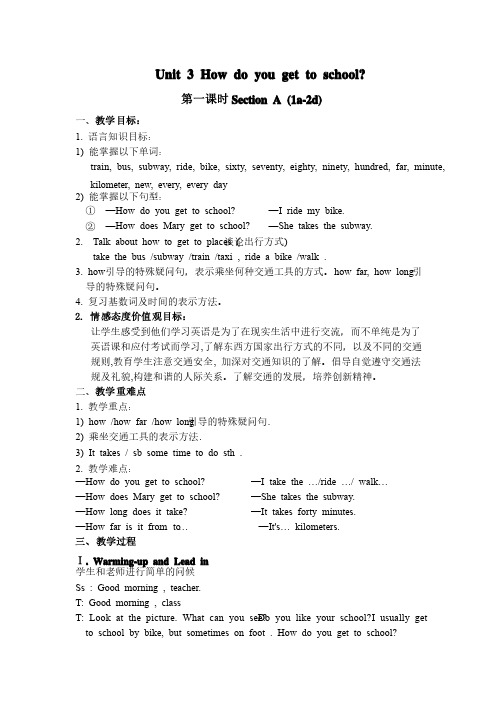
Unit 3 How do you get to school?第一课时Section A (1a-2d)一、教学目标:1. 语言知识目标:语言知识目标:1) 能掌握以下单词:能掌握以下单词:train, bus, subway, ride, bike, sixty, seventy, eighty, ninety, hundred, far, minute, kilometer, new, every, every day 2) 能掌握以下句型:能掌握以下句型:① —How do you get to school? —I ride my bike. ② —How does Mary get to school? —She takes the subway. 2. Talk about how to get to places (谈论出行方式) take the bus /subway /train /taxi , ride a bike /walk . 3. how 引导的特殊疑问句,表示乘坐何种交通工具的方式。
how far, how long 引导的特殊疑问句。
导的特殊疑问句。
4. 复习基数词及时间的表示方法。
复习基数词及时间的表示方法。
2. 情感态度价值观目标:让学生感受到他们学习英语是为了在现实生活中进行交流,而不单纯是为了英语课和应付考试而学习,了解东西方国家出行方式的不同,了解东西方国家出行方式的不同,以及不同的交通以及不同的交通规则,教育学生注意交通安全, 加深对交通知识的了解。
倡导自觉遵守交通法规及礼貌,构建和谐的人际关系。
了解交通的发展,培养创新精神。
二、教学重难点1. 教学重点:教学重点:1) how /how far /how long 引导的特殊疑问句. 2) 乘坐交通工具的表示方法. 3) It takes / sb some time to do sth . 2. 教学难点:教学难点:—How do you get to school? —I take the …/ride …/ walk… —How does Mary get to school? —She takes the subway. —How long does it take? —It takes forty minutes. —How far is it from … to … —It's It's…… kilometers. 三、教学过程Ⅰ. Warming-up and Lead in 学生和老师进行简单的问候学生和老师进行简单的问候Ss : Good morning , teacher. T: Good morning , class T: Look at the picture. What can you see? Do you like your school? I usually get to school by bike, but sometimes on foot . How do you get to school? Ss 按实际情况作答按实际情况作答S1: I ride my bike. S2: I go by bus. S3: ………T: V ery good. You’re clever. Let’s learn Unit 4 Section A. 之后板书:之后板书:“Unit 4 How do you get to school?”Ⅱ. Presentation 1. T: If you are here, but your school is in Shanghai. How do you get to school? Ss: I take the bus /plane/ boat / ship / car / taxi I ride a bike / motorbike T: Do you know any other way? 2. Teacher shows pictures on the big screen .归纳出行方式和常用短语. Ask some questions about how you get to…? (让学生积极主动的思考想象总结,多媒体增加趣味性,加强直观性,效果事半功倍) 3. Show a picture about Part 1, on the screen. Point at girls or boys in the picture. Ask students to answer and write in the blanks. S1 : How does he / she go to school? S2 : He / She … …Ⅲ. 1a T: Look at the picture on your book. Match the words with the picture. (学生们完成1a 的学习任务,然后校对答案) Ⅳ. Listening 1. Make sure the Ss know what to do. Give them an example orally if possible. 2. Read the names in the box. 3. Play the tape and check the answers. Ⅴ. Pair work Ask two students to read the dialogue in the speech bubbles to the class. Then ask students students to to to work work work in in in pairs. pairs. pairs. Ask Ask Ask and and and answer answer answer how how how students students students get get get to to to school school school in in in the the picture. Finally ask some pairs of students to present their conversations to the class. Ⅵ. Listening 1. 1. Revise Revise Revise the the the numbers, numbers, numbers, first, first, first, zero~nine, zero~nine, zero~nine, next, next, next, ten~nineteen, ten~nineteen, ten~nineteen, then, then, then, twenty, twenty, thirty, forty forty……finally, twenty-one, twenty-two… Teach the new word "hundred". 2. Play the tape for the students to finish 2a. Then play again and check the answers Ⅶ. Presentation Section A (1a-2d) 1. —How do you get to school? —I ride my bike? —How does Mary get to school? —She takes the subway. 2. 表达“几十” 个位数字+ty twenty, thirty, 一定要用连字符 twenty-five, sixty-nine 表达“几十几” 一定要用连字符hundred one hundred, two hundred 3. ① How does Jane get to school? ② How far is it from home to school? ③ How long does it take to get to school from her home? 课后反思:引入环节可以先让学生以小组活动为主要练习方式,引入环节可以先让学生以小组活动为主要练习方式,让学生讨论他们让学生讨论他们所知道的交通工具,所知道的交通工具,并把它们画出来,并把它们画出来,并把它们画出来,由小组长汇总,由小组长汇总,由小组长汇总,并填表向全班同学展示讨并填表向全班同学展示讨论结果,论结果,全班评选出哪一组知道的交通工具多,全班评选出哪一组知道的交通工具多,全班评选出哪一组知道的交通工具多,并看谁画得棒。
英语人教版七年级下册Unit3 reading 教案

What can we do to make their dream come true?
6. Can the boy’s dream come true?
Why not?
1.对文章进行逐层分析,抽丝剥茧,引导学生对目标文章有一个通透的理解。
3.学生从中能够锻炼沟通合作能力。
Step3.
展示交流
(6分钟)
帮助学生用投影进行展示,聆听、欣赏并给予点评。
小组代表到教室前进行展示,并读出自己的海报内容。
通过小组合作成果的展示,学生互通有无的同时体会合作后的成就感、提高自信心并能更全面地了解交通安全。
Step4.
总结拓展
(1分钟)
总结道路安全同时拓展食品安全、用火用电安全及语言安全等,并给予简单有效的建议。然后领读名言,体会珍惜生命。
2.设置不同难度问题让各个程度的学生都能有所表现,增强自信,从而更乐意从事英语阅读。
3.最后开放型问题启迪学生思考:(1)怎样尽己所能关爱他人;(2)生命只有一次,我们要珍爱生命。怎样在上学路上珍爱生命?(引入下一个任务。)
任务2:校本阅读资料。
通过制作交通安全主题海报,进一步落实上学路上安全问题。
教学目标
语言能力目标
1)巩固表达采用怎样的交通方式去某地。
2)阅读短文,获取并整合相关信息。
3)学会表达简单的交通规则。
思维品质目标
学会关爱他人,合作共赢。
学习能力目标
强化听说读写的能力及合作学习的能力。
文化意识目标
倡导自觉遵守交通法规,珍爱生命,构建和谐的人际关系。
教学
重难点
重点
1)通过进行听、说的训练,来提高学生们综合运用所学知识的能力。
人教版七年级下册unit3阅读教案
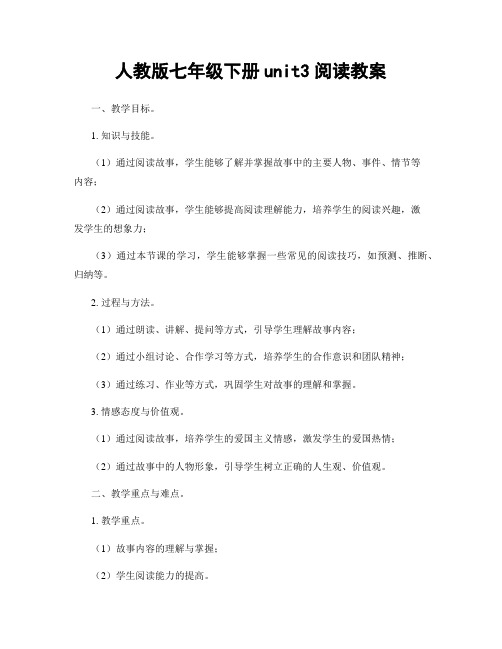
人教版七年级下册unit3阅读教案一、教学目标。
1. 知识与技能。
(1)通过阅读故事,学生能够了解并掌握故事中的主要人物、事件、情节等内容;(2)通过阅读故事,学生能够提高阅读理解能力,培养学生的阅读兴趣,激发学生的想象力;(3)通过本节课的学习,学生能够掌握一些常见的阅读技巧,如预测、推断、归纳等。
2. 过程与方法。
(1)通过朗读、讲解、提问等方式,引导学生理解故事内容;(2)通过小组讨论、合作学习等方式,培养学生的合作意识和团队精神;(3)通过练习、作业等方式,巩固学生对故事的理解和掌握。
3. 情感态度与价值观。
(1)通过阅读故事,培养学生的爱国主义情感,激发学生的爱国热情;(2)通过故事中的人物形象,引导学生树立正确的人生观、价值观。
二、教学重点与难点。
1. 教学重点。
(1)故事内容的理解与掌握;(2)学生阅读能力的提高。
2. 教学难点。
(1)培养学生的阅读兴趣;(2)引导学生进行深层次的阅读理解。
三、教学过程。
1. 导入新课。
通过谈论一些与故事有关的话题,引起学生的兴趣,如“你喜欢听故事吗?为什么?”、“你最喜欢的故事是什么?为什么?”等。
2. 阅读故事。
(1)教师朗读故事,学生跟读;(2)教师讲解故事中的生词、短语等;(3)学生分组讨论故事中的主要人物、事件、情节等内容;(4)学生展示小组讨论成果,进行互动交流。
3. 操作练习。
(1)学生个人完成故事相关的练习题,如选择题、判断题等;(2)学生交流答案,订正错误。
4. 拓展延伸。
(1)教师提出一些与故事相关的问题,引导学生进行深层次的思考和讨论;(2)学生进行小组合作,展示他们对故事的理解和想法;(3)学生进行个人总结,写下对故事的感想。
5. 作业布置。
布置阅读相关的作业,如写一篇关于故事的读后感,或者选择一段故事进行朗读等。
四、教学反思。
本节课通过故事的阅读,引发学生的阅读兴趣,培养学生的阅读能力,同时也培养了学生的合作意识和团队精神。
人教版七年级下册unit3-How-do-you-get-to-school-单元教案
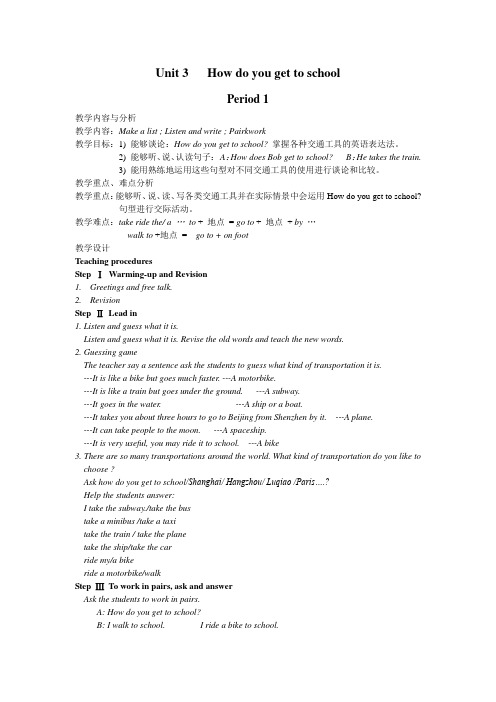
Unit 3 How do you get to schoolPeriod 1教学内容与分析教学内容:Make a list ; Listen and write ; Pairkwork教学目标:1) 能够谈论:How do you get to school? 掌握各种交通工具的英语表达法。
2) 能够听、说、认读句子:A:How does Bob get to school? B:He takes the train.3) 能用熟练地运用这些句型对不同交通工具的使用进行谈论和比较。
教学重点、难点分析教学重点:能够听、说、读、写各类交通工具并在实际情景中会运用How do you get to school?句型进行交际活动。
教学难点:take ride the/ a …to + 地点= go to + 地点+ by…walk to +地点= go to + on foot教学设计Teaching proceduresStep ⅠWarming-up and Revision1.Greetings and free talk.2.RevisionStep ⅡLead in1. Listen and guess what it is.Listen and guess what it is. Revise the old words and teach the new words.2. Guessing gameThe teacher say a sentence ask the students to guess what kind of transportation it is.---It is like a bike but goes much faster. ---A motorbike.---It is like a train but goes under the ground. ---A subway.---It goes in the water. ---A ship or a boat.---It takes you about three hours to go to Beijing from Shenzhen by it. ---A plane.---It can take people to the moon. ---A spaceship.---It is very useful, you may ride it to school. ---A bike3. There are so many transportations around the world. What kind of transportation do you like to choose ?Ask how do you get to school/Shanghai/ Hangzhou/ Luqiao /Paris….?Help the students answer:I take the subway./take the bustake a minibus /take a taxitake the train / take the planetake the ship/take the carride my/a bikeride a motorbike/walkStep ⅢTo work in pairs, ask and answerAsk the students to work in pairs.A: How do you get to school?B: I walk to school. I ride a bike to school.I take a bus to school. I take a car to school.I take the subway to school. I take the train to school.Step ⅣPresentation1. First ask two students to ask and answer in pair.Then ask the other students “how does he/she get to school?”He/She takes the subway. /……rides his/her bike……walks.Step ⅤGroup workAsk the students to do group work.A: How do you get to school?B: I take the bus. / ride my bike/ bicycle./ walk.C: How does he /she get to school?He/She takes the bus/… rides his/her bike/bicyc le ./ walks.Step ⅥWork on 1a and 1b.1. To do Section A 1a look at the picture and write down the way of transportation.2. To listen to the tape and finish1b.Step ⅦPresentationAsk “h ow does Bob get to school?’ Help them answer he takes the train.Then ask “how does Paul get to school?” "He walks."Say Paul usually walks to school. He goes to school on foot.Show some pictures to students. Ask them to say like this.My father rides a bike to work every day. =My father goes to work by bike every day. Step ⅧTo work in pairs, ask and answerShow some pictures to the students then ask then to work in pairs.A: How do you get to......? B: I take/ride/walk......I get to school...by.../on...Step ⅨSummaryTake/ride the/a ...to+地点=go to +地点+by....Walk to+地点=go to +on foote.g. He often takes the subway to work.=He often goes to work by subway.注意:当home, here, there 作地点时to 不要。
人教新目标七年级英语下册教案 Unit3 复习课 教学设计

教学设计设计主题How do you go to school?1.整体设计思路、指导依据说明本节课结合教材和学生的特点,依据新英语课程标准的要求,从激发学生的学习兴趣,丰富生活经验和提高认知水平出发,科学地整合教材,安排教学内容,合理设计教学任务,开展形式多样的教学活动,让学生跟着老师大胆实践,积极参与,共同合作交流,帮助学生在任务性的教学途径下提高语言运用能力,并逐步形成自主学习能力.本节课教师充分发挥了引路人的作用,利用视频, Guess, Do as I do等游戏让学生轻松愉快地体会并掌握了交通方式的表达,课堂具有趣味性及高效性。
2.教学背景分析教学内容分析:本课时通过对学生上学方式的讨论,逐步引出重点句型How do you go to school?-By+交通工具;How long does it take sb. to do sth.?从而过渡到贫穷孩子乘索道上学的问题上来,情感教育寓于其中。
学生情况分析:学生在新课结束后,对于所学知识大多没有整体的概念,形不成知识系统。
复习课的任务最重要的一点就是帮助同学们形成对重点知识清晰的图像。
根据本阶段学生的特点,在复习时采用活动教学的学习策略,复习词汇,归纳重点句型,如猜谜语,给亮亮写信等方式将所学的语言运用到实践中。
做到既能巩固所学知识,又能提高解决问题的能力以及综合运用语言能力。
3.教学目标分析1、知识目标:掌握交通方式的表达;能根据图片复述长篇文章。
2、能力目标:---熟练运用句型How do you get to school?---By bus.谈论交通方式。
3、情感目标:通过对长篇文章的欣赏,学生学会体会贫困孩子对上学的渴望并珍惜现在的生活。
4.教学重点、难点分析教学重点:1. by+交通工具与take a/ the +交通工具的相互转换。
教学难点:1. It takes sb. some time to do sth. 2.长篇文章的理解与复述;书面表达。
人教版新目标英语七年级下册Unit 3 写作教学案

七年级下册Unit 3 How do you get to school ?写作教学案(教师使用)【话题】交通(Transportation)【写作目标】要求学生能能够熟练表达或者询问怎样去某地。
【课前任务】一、写出下列短语。
1、客车上落站2、火车站3、地铁站4、步行5、坐地铁6、村庄7、桥 8、多远参考答案:1.bus stop 2.train station 3.subway station 4.on foot 5.take the subway 6.village 7. bridge 8. how far二、根据汉语意思完成下列句子。
1、我花费一小时坐火车到那里It ____________ ____________ an hour ____________ get there .2、我坐船去上班。
I get to work ____________ ____________.3、学校和村庄之间有一条河。
There is a very big river ____________ their school ____________ the village.4、还要过多久你就到达北京?____________ ____________ will you____________ ____________ Beijing?5、从学校到医院有多远?____________ ____________ is it ____________ the school ____________ the hospital?参考答案:1. takes me , to 2.by boat 3. between , and 4.How soon , arrive in/get to 5.How far , from , to三、写出与本话题有关的词汇和句型。
常用词汇:take the train,take the bus,ride a bike,walk经典句型:How do you get to school?It takes 20 minutes.How long does it take to get to school? It takes about15 minutes.How far is it from your home to school? It's only about two kilometers.【课中任务】读写结合一、A. 信息归纳阅读下面短文,然后按照项目要求填写所缺信息。
+Unit+3全单元教案2023-2024学年人教版英语七年级下册

Unit 3 How do you get to school?全单元教案课题:Unit3 Section A (1a-1c)教学目标:语言能力、思维品质、文化品格、学习能力语言能力:1、单词:get to, train, bus, subway, take the subway, ride, bike, ride a bike2、句型:—How do you get to school? →I walk/ ride my bike.思维品质:通过听、说等一些活动培养良好的听力习惯和能力,再通过通过独学和小组合作,学会使用本单元重点句型。
文化品格:1、通过互相谈论如何去上学,增进同学之间的了解和友情。
2、了解英语国家学生的学习生活,增强跨文化交际的意识。
学习能力:通过对话练习和小组合作,能够进行角色扮演并创编对话。
教学重点:1.单词:get to, train, bus, subway, take the subway, ride, bike, ride a bike2.句型:—How do you get to school? →I walk/ ride my bike.教学难点:1.熟练运用所学的词汇、句型表达和交流信息。
2.正确运用本课中所学的表示交通方式的短语,表述自己如何去上学。
德育渗透:正确的表达如何去某地。
教学准备:PPT课件教学时间:一课时教学过程:一、复习巩固,预习检测(时间分配:5分钟)让学生做根据简笔画猜交通工具的游戏进行热身。
教师在黑板上画出某种交通工具的一部分,然后让学生猜是哪一种交通工具,看谁猜得既对又快。
(游戏的目的是活跃课堂气氛,充分调动学生学习的积极性,培养学生学习英语的兴趣;同时达到巩固旧知识、进而引出要学习的新知识的目的。
)For example:T:I will draw some kinds of transportation on the blackboard. Can you guess what they are?When you give me the correct answer,I will write the words on the blackboard.(教师画公共汽车、火车、自行车、地铁等交通工具,让学生去猜。
人教版七年级英语下册教案Unit 3 How do you get to school第一课时
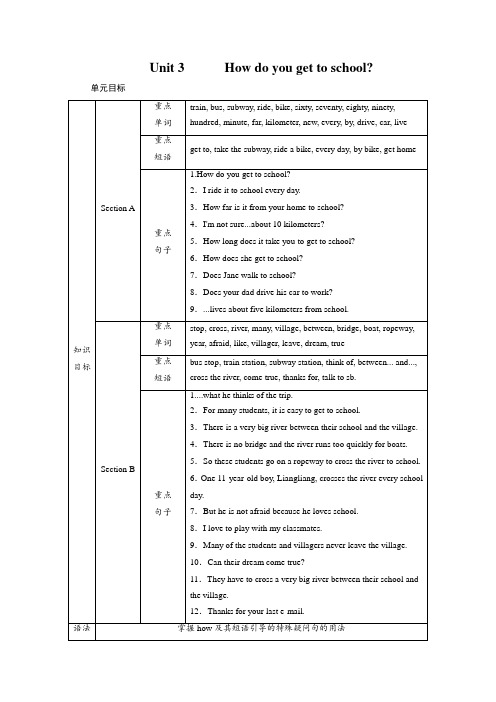
Unit 3How do you get to school?单元目标第一课时Section A (1a-2e) 课时目标3.How far is it from your home to school? 从你家到学校有多远?4.I'm not sure...about 10 kilometers?我不确定……大约10公里?5.How long does it take you to get to school? 你到学校要用多长时间?教学难点教会学生使用不同的方法表达交通方式;掌握本课时的重点短语和句型及其用法;初步了解how的相关用法自主学习根据句意及音标提示写出单词及其汉语意思。
1.We will go to Beijing by train /treɪn/. 火车2.My mother goes to work by subway /'sʌbweɪ/. 地铁3.She can ride /raɪd/ a motorcycle. 骑4.He walked two hundred /'hʌndrəd/ and sixty /'sɪkstɪ/ miles in thirty days. 一百;六十5.A nice little Italian restaurant is not far /faː(r)/ from here. 远;远的6.I want to buy a new /njuː/ pen. 新的7.I take the bus to go to school every /'evrɪ/ day. 每一;每个教学过程环节1新课导入T:Hello, everyone!How many kinds of transportation do you know? Can you call their names?Ss:Taxi, subway, bike, train, plane, bus...T:OK, good. Look at the pictures and answer the questions.T:These pictures are about the transportation that you have mentioned. I usually get to school by bike, but sometimes on foot.Can you tell me how you get to school?S1:I ride my bike.S2:By bus.T:OK! Today we will learn more about transportation.Ss:That sounds great!设计意图:教师通过展示交通工具的图片吸引学生的注意力,以师生之间对话的方式自然地过渡到本课时的话题上来,同时也调动了学生参与课堂的积极性。
英语七年级下人教版新课标Unit_3_How_do_you_get_to_school SectionA 1a-1c教学设计新部编版
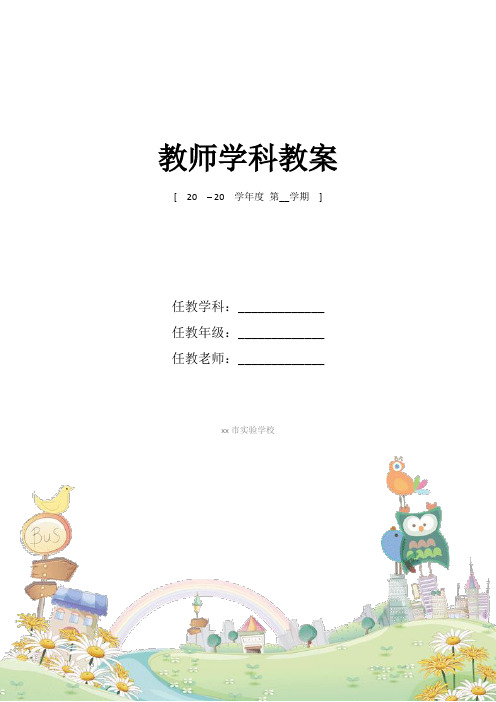
教师学科教案[ 20 – 20 学年度第__学期]任教学科:_____________任教年级:_____________任教老师:_____________xx市实验学校英语七年级下人教版新课标Unit 3 How do you get to school Section A 1a-1c教学设计熨斗中学阮班玉一、概述本单元以“交通工具”为中心话题,围绕谈论“How do you get to school?”而展开教学及运用How long/How far 询问去某地的时间和距离,而Section A (1a-1主要是学习交通工具的单词和运用how引导的特殊疑问句,询问到达目的地的,这一话题贴近学生们的日常生活,它继第三单元谈论“假日计划”后安排这样一个话题,符合学生的认知结构和年龄特征,它将为本单元后面的课时做好铺垫,也为学生口语交际打下基础。
本课是本单元的第一课时。
本单元认识掌握交通工具,然后学习短语take the subway, take the train, ride a bike, walk等,最后学习句型How do you get to school? I take the bus. 在本节课中学生要学习练习含有第一,二人称和第三人称单数,How 引导的特殊疑问句。
How doe Mary get to school? She takes the subway.二、教学目标分析:1. 知识与技能:1) 能掌握以下单词:bus, train, subway, taxi, walk, pane, ride, bike.2) 能掌握以下短语:take the bus, take the subway, take the train, take the taxi, take the plane, take the car,drive the car, ride the bike, walk.3) 能掌握以下句型:①—How do you get to school?ride my biketake the busI take the subway to school.take the taxitake the carwalk②—How does Mary get to school?rides my biketakes the busShe takes the subway to school.takes the taxitakes the carwalks4)学会将课内外习得的生词和习惯用语、谈论交通工具等综合运用。
七年级英语下册Uni 《Donteatinclass》教案 人教版

七年级英语下册Unit 3《Don't eat in class》教案人教版一、教学目标1. 知识目标a. 能够听懂、会说、会读本课的生词和短语:classroom, library, teacher's office, puter lab, science lab, don't eat in class, read a book, write on the board等。
b. 能够理解并在适当的情境中运用一般现在时的否定句和疑问句。
2. 能力目标a. 能够用英语简单描述学校中的不同场所和禁止做的事情。
b. 能够听懂、会说、会读关于学校规则的对话。
3. 情感目标a. 培养学生的团队协作精神,使他们意识到遵守学校规则的重要性。
二、教学重难点1. 重点:能够运用一般现在时的否定句和疑问句进行交流。
2. 难点:正确运用一般现在时的否定句和疑问句描述学校规则。
三、教学方法1. 情境教学法:通过设定学校场景,让学生在真实情境中学习英语。
2. 交际法:通过小组活动,让学生在实际交流中掌握英语。
3. 任务型教学法:通过完成具体任务,让学生在实践中学习英语。
四、教学步骤1. 热身(5分钟)a. 教师与学生用中文进行简单的对话,询问学生对本课内容的预习情况。
b. 学生进行简单的自我介绍,介绍自己的学校和生活。
2. 导入(10分钟)a. 教师向学生介绍本课的主题:学校规则。
b. 教师引导学生思考并讨论学校中的禁止做的事情。
3. 课堂讲解(15分钟)a. 教师讲解一般现在时的否定句和疑问句的构成和用法。
b. 教师通过示例,让学生理解并运用一般现在时的否定句和疑问句描述学校规则。
4. 课堂练习(10分钟)a. 学生分组进行练习,用一般现在时的否定句和疑问句描述学校规则。
b. 教师选取部分学生进行展示,并给予评价。
5. 总结与作业布置(5分钟)a. 教师对本课内容进行总结,强调一般现在时的否定句和疑问句的运用。
2024年人教版七年级英语下册教案Unit3 第4课时
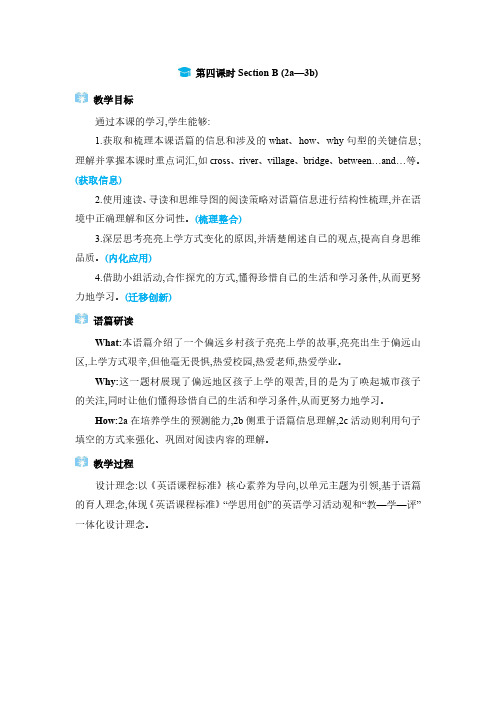
第四课时Section B(2a—3b)教学目标通过本课的学习,学生能够:1.获取和梳理本课语篇的信息和涉及的what、how、why句型的关键信息;理解并掌握本课时重点词汇,如cross、river、village、bridge、between…and…等。
(获取信息)2.使用速读、寻读和思维导图的阅读策略对语篇信息进行结构性梳理,并在语境中正确理解和区分词性。
(梳理整合)3.深层思考亮亮上学方式变化的原因,并清楚阐述自己的观点,提高自身思维品质。
(内化应用)4.借助小组活动,合作探究的方式,懂得珍惜自己的生活和学习条件,从而更努力地学习。
(迁移创新)语篇研读What:本语篇介绍了一个偏远乡村孩子亮亮上学的故事,亮亮出生于偏远山区,上学方式艰辛,但他毫无畏惧,热爱校园,热爱老师,热爱学业。
Why:这一题材展现了偏远地区孩子上学的艰苦,目的是为了唤起城市孩子的关注,同时让他们懂得珍惜自己的生活和学习条件,从而更努力地学习。
How:2a在培养学生的预测能力,2b侧重于语篇信息理解,2c活动则利用句子填空的方式来强化、巩固对阅读内容的理解。
教学过程设计理念:以《英语课程标准》核心素养为导向,以单元主题为引领,基于语篇的育人理念,体现《英语课程标准》“学思用创”的英语学习活动观和“教—学—评”一体化设计理念。
教学目标学生活动效果评价Lead-in通过呈现课文标题及图片,引导学生预测文章的大体内容,并利用读前阶段对文段标题及图片的讨论,渗透一部分生词,从而减轻阅读时的生词压力,做好阅读铺垫1.Greeting.2.Show the title and the picture of thepassage.Let students guess what thestory is about.Who are they?They’re going to school on aropeway.Do you think it’s easy forthem?New words:cross the river,bridge,ropeway,dangerous,afraid.教师鼓励学生对课文内容进行大胆预测,根据学生的表现预判学生的能力并了解学生的兴趣,根据学生的回答情况给予帮助和鼓励设计意图通过预测导入本文段主体,并让学生预测文段大致内容,引起他们的思考,激发他们的思维。
人教版英语七年级下册Unit3第三课时SectionA(GrammarFocus-3c)教案
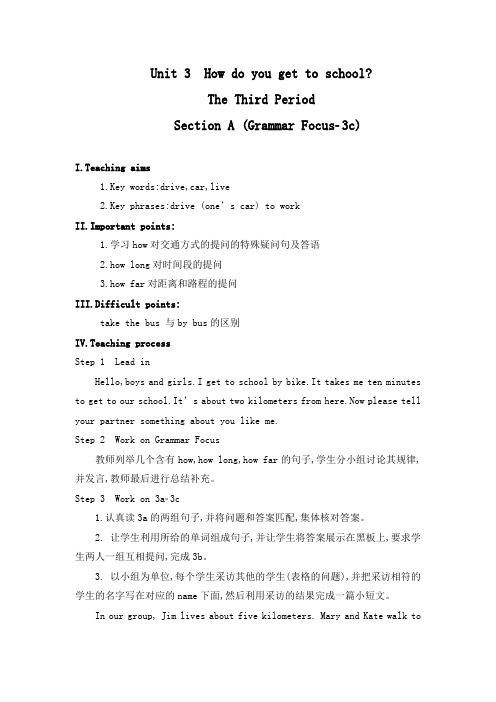
Unit 3 How do you get to school?The Third PeriodSection A (Grammar Focus3c)I.Teaching aims1.Key words:drive,car,live2.Key phrases:drive (one’s car) to workII.Important points:1.学习how对交通方式的提问的特殊疑问句及答语2.how long对时间段的提问3.how far对距离和路程的提问III.Difficult points:take the bus 与by bus的区别IV.Teaching processStep 1 Lead inHello,boys and girls.I get to school by bike.It takes me ten minutes to get to our school.It’s about two kilometers from here.Now please tell your partner something about you like me.Step 2 Work on Grammar Focus教师列举几个含有how,how long,how far的句子,学生分小组讨论其规律,并发言,教师最后进行总结补充。
Step 3 Work on 3a3c1.认真读3a的两组句子,并将问题和答案匹配,集体核对答案。
2. 让学生利用所给的单词组成句子,并让学生将答案展示在黑板上,要求学生两人一组互相提问,完成3b。
3. 以小组为单位,每个学生采访其他的学生(表格的问题),并把采访相符的学生的名字写在对应的name下面,然后利用采访的结果完成一篇小短文。
In our group, Jim lives about five kilometers. Mary and Kate walk toschool. Sally takes a bus to school. Tom goes to school by bike. Jim needs about an hour to get to school. Mary and Kate need about ten minutes to get to school.Language points1.drive的用法drive 动词,意为“开车;驾驶”。
- 1、下载文档前请自行甄别文档内容的完整性,平台不提供额外的编辑、内容补充、找答案等附加服务。
- 2、"仅部分预览"的文档,不可在线预览部分如存在完整性等问题,可反馈申请退款(可完整预览的文档不适用该条件!)。
- 3、如文档侵犯您的权益,请联系客服反馈,我们会尽快为您处理(人工客服工作时间:9:00-18:30)。
Unit 3 How do you get to school?教案Part 1:Teaching design (第一部分:教学设计)Structures: How questions; Affirmative and negative statementsTarget language:How do you get to school? I take the bus.How long does it take? It takes 20 minutes.How far is it? I t’s 10 miles.Vocabulary: get to, how far, bicycle, subway, car, train, bus stop, train station, bus station, subway station, minute, kilometer, mile, transportation, calendarLearning strategies: Personalizing; I nferring vocabularySECTION AGoals●To learn to use How questions, affirmative and negative statements●Lean to talk about how to get to places, how long it takes to go to places, and how far theplaces are●To talk about kinds of transportationProceduresWarming up by talkingHello, everyone! What’s the weather like today? It’s a sunny day with a gentlebreeze. It’s comfortable. So this morning I come to school by bike. It took menearly 50 minutes. You know I live far from school. I often take buses to comehere. But it takes me more than an hour. What about you? Today, let’s talkabout how you go from one place to another. And wewill talk about the time it takes to get to places and how far it is between twoplaces.1a Looking and writingOpen your book at page19. Look at the picture carefully and read thedialogue. Then please write how the students in the picture get to school inthe morning in the chart.Sample answers:1. take the subway2. ride a bike3. take the bus4. take the train5. walk(on foot)6. take a boat7. take a taxi 8. go in a parent’s car1b Listening and writingLook at the picture again. How do students get to school? Let’s listen toa conversation between two people talking about this. Listen carefullyand write the number of the name in the white box next to the student.Please do it individually. Then let’s check the answer.Answers:1. Bob takes the train.2. Mary takes the subway.3. John takes the bus.4. Paul walks.5. Yang Lan walks.TapescriptA: How do Bob and Mary get to school?B: Bob takes the train and Mary takes the subway.A: How does John get to school?B: He takes the bus.A: How do Paul and Yang Lan get to school?B: They walk. Look, there they are waling now!Now read the tapescript, shadow the how questions and underling the expressions.1c Doing pairworkPlease read the dialogue on page 19 in the box. And make your own conversations about how the people in the picture get to school with their partner. Then I’ll ask some pairs to say their dialogue. Sample dialogueA: How does Bob get to school?B: He takes the train.A: Does John take the train to school, too?B: No. He takes the bus.A: What aboutMary and Paul?B: Paul walks,and Mary takes thesubway.A: And Yang Lan walks, does she?B: Yes, she does.2a Listening and repeatingListen to these numbers and repeat. Please pay attention to the pronunciation.Tapescript32, 40, 50, 60, 70, 80, 90, 1002b Writing the numbersforty-six 46 thirty-three 33 seventy-two 72one hundred and five 105 fifty-eight 58 ninety-nine 99sixty-one 61 eighty-four 842c Listening and checkingNow please look at the five transportation pictures. And we’ll listen to two conversations. The people are talking about how students get to school and how long it takes. Listen carefully and put a checkmark to show the kinds of transportation they talk about. Check your answer.40 minutes 35minutes25minutes10 minutesListen carefully again and match the time with the kinds oftransportation. Let’s check the answers.TapescriptConversation 1Boy: How do you get to school?Girl: I take the train.Boy: How long does it take?Girl: Oh, around forty minutes. How aboutyou?Boy: I take the subway.Girl: How long does that take?Oh, around thirty-five minutes.Conversation 2Girl: How do you get to school, Tom?Tom: I ride my bike.Girl: How long does it take?Tom: It takes around twenty-five minutes.Tom: How do you get to school?Girl: I walk.Tom: And how long does that take?Girl: It only takes ten minutes.Look at the sentences on the board. “They take the train. It takes about forty minutes.”“Take the train” means to ride the train. And we also use “take” to talk about a length of time. For example, it takes me 20minutes to get to school. So we use the same word, take, in two different ways. Now read the tapescript, shadow the how questions and underling the expressions.2d Doing pairworkNow please make your own conversations about how you get to school and how long it takes. Read the example dialogue first then make yours with your partner.Example:A: How do you get to school?B: well, I usually walk but sometimes I take the bus.A: How long does it take?B: It takes about 25 minutes to walk and 10 minutes by bus. What about you? A: I get to school by bike, sometimes I take my father’s car.B: Oh, how long does it take?A: It takes around 40 minutes by bike and 15 minutes by car.3a Reading and writingSo far you have learned to talk about how you get to school and how long it takes.The passage you will learn in this part tells us something about Li Lei. Pleaseread the questions about Li Lei in the speech bubbles. Then read the passage andwrite the answers to the questions on the line. You should complete the activityindividually.OK, now let’s check the answers.1How does he 2 How long does 3 How far is it fromget to school? it take? his home to school?By bike and It usually takes About 10 kilometers.by bus. about 35 minutes.Now read the passage following the tape sentence by sentence. Please pay attention to the pronunciation and intonation of the native readers and try to imitate them. Then draw lines under the useful phrases and structures.Lin Fei’s home/ is about 10 kilometers /from school. He gets up /at six o’clock/ every day, showers, and has a quick breakfast. Then/ he leaves for school/ at around six-thirty. First, he rides his bicycle/ to the bus station. That takes about ten minutes. Then/ the early bus/ takes him to school. The bus ride/ usually/ takes about 25 minutes.Ok, we have got to know something about Li Lei. What about you? How far are your homes from school? What time do you get up? How do you get to school? Let’s ask some students to say something about you.3b Doing pairworkLook at the pictures on page 21. Can you name each form of transportation? They are easy to you. Read the time and distance that goes with each form of transportation. Pay attention to “mile”, which is a common measure of distance in some western countries. (1 mile=1.6 kilometers). Read the example dialogue in the box.Now make your own conversations using the information in the picture with your partner.A: How do you get to school?B: I take the train.A: How far is it from your home to school?B: It’s eight miles.A: How long does it take you to get from home toSchool ?B: It takes 35 minutes.A: How do you get to school?B: I walk.A: How far is it from your home to school?B: It’s two miles.A: How long does it take you to get from home to school ?B: It takes 40 minutes.A: How do you get to school?B: I take the bus.A: How far is it from your home to school?B: It’s four miles.A: How long does it take you to get from home to school?B: It takes 15 minutes.OK. Stop here please. Let’s ask some pairs to say their dialogues.4 Talking and writingWell done everyone! Now let’s play a game: Info Gap Race! This time you work in groups of three. You decide which one is A, which one is B and which one is C. Please read the instruction. You ask each other questions to learn information for your chart, and then write the answers on the chart in your book. Don’t look at others’ pages please. The first group to fill in all the blanks is thechampion.Who How How long How far1. Maria bus twenty minutes five miles2. John bike ten minutes six miles3. Liu Pei subway fifteen minutes eight milesSample dialogue:C:How does Maria get to school?A: She takes the bus. How long does it take Maria to get to school?B: It takes her twenty minutes. How far is it from her home to school?C:It’s five miles.Closing down by asking and answering(using the useful information learned in this part)*How do you get to school?*I usually walk, but sometimes I take the bus.*How long does it to take you to get from your home to school?*It takes 25 minutes.*How far is it from your home to school?*It’s around 4miles. A bus station Section BGoals●To learn to use: bus stop, train station, subway station●To learn to talk about how to get to places further.ProceduresWarming up by asking some individuals questionsHow does Li Lei get to school? First, he rides his bicycle to the bus station. Then he takes the early bus to school. Do you know the bus station? It’s a place where trains stop here. Today we’ll study some other “stations”.1a Looking and matchingLook at the four phrases on the top of page 22 and read them loudly. Then match the words with the pictures.Answers: 1. b bus stop 2. a train station 3. c bus station 4. d subway station1b Doing pairworkRead the dialogue in the box first. Then suppose you use two kinds of transportation to get to school. Now make your own dialogues to tell your partner how you get to school, using the phrases in 1a.Sample dialogue:A: How do you get to school?B: Well, I ride my bike to the subway station. Then I take the subway. What about you?A: First, I walk to the bus stop. Then I take the bus to school.A: How does your father get to his school?B: Well, he walks for ten minutes to Bus No. 11. He takes the bus and gets off at Da Yingpan. Then he walks again for five minutes to his classroom.2a Listening and checkingOK, now. Let’s listen to the conversation between Tina and Thomas. What does Thomas want to know about Nina? Here is a list of information that Thomas wants to know. I’ll ask some students to read lines to the class. Then listen carefully and put a checkmark in front of each thing that Thomas wants to know.Thomas wants to know…√where Nina lives.how far from school she lives.how long it takes Nina to get to school.√how she gets to school.what she thinks of the transportation.2b Listening and checkingLook at the pictures on page 22 with a blank line in front of each. They show the ways of how to get to school. Which one is Nina’s? Listen carefully and put a checkmark next to the picture that shows how Nina gets to school.1.—to ride a bike to the subway—to take the subway tothe bus—to walk from the bus stop to the school2.√to walk to the bus—to take the bus to the subway—totake another bus after the subway—to walk from the busstop to the school.TypescriptThomas: Where do you live, Nina?Nina: New Street.Thomas: So, how do you get to school?Nina: Well, first I walk to the bus stop.Thomas: Uh-huh.Nina: I take a bus to the subway station. Then I take the subway.Thomas: Yeah…Nina: Next I take a bus to the bus stop on 26thStreet. Finally I walk.You may turn to the tapescript to read it, underlining theexpressions and shadowing the how questions.2c Doing groupworkNow make your conversations about how Nina gets to school in groups of four. You can use the pictures in activity 2b. Pay more attention to the sentence starters: S he…; Next, she…; Then, she… in the box and use them in your conversation.Sample dialogue:A: How does Nina get to school?B: She walks to the bus stop.C: Next, she takes a bus to the subway station.D: Then she takes another bus to the bus stop on 26th street after the subway.A: Finally she walks to school.Now let’s ask some of you to say your descriptions to the class.3a Reading and writingNow you can say something about how you get to school.Do you want to know how students around the world get to school? Read the article on page 23, and then decide if the statements are true or false in your exercise book.Check the answers:T 1. In North America, not all students take the bus to school.T 2. Other parts of the world are different from the United States.F 3. In Japan, the three most popular ways of getting to school are bus, train and bike. (Students take trains, or walk, or ride bikes)F 4. In China, bikes and buses are the most popular means of transportation. (It depends on where you are)T 5. Students in Hongshanhu and Kaishandao have to take a boat to get to school.Read the article once again, this time, to slash/ the sentences, underline the useful expressions in it and shadow the connectives. After school, you are going to write them down in your notebook. How do students around the world get to school?In North America, most students/ go to school/ on the school bus. Somestudents/ also walk/ or ride bikes to school. In other parts of the world,things are different. In Japan, most students/ take trains to school,although others also walk/ or ride their bikes. In China, it depends on /where you are. In big cities, students usually ride bikes to school/ or take buses. And in places/ where there are rivers and lakes, like Hongshanhu and Kaishandao, students usually go to school/ by boat. That must be a lot more fun/ than taking a bus!3b Reading and writingLook at the chart. Then read the article and fill in the blanks. You can findthe answers in the chart. Please complete the activity individually.Check the answers:How do the students get to Garden High School?At Garden High School, most students ride their bikes to school. Many students walk. Some students drive. Other students take the bus. A small number of students take the subway.3c WritingJust now we filled in an article about how students get to Garden High School. What about you?How do students in our class get to school? Let’s make a survey and listyour ideas on the board. You can use the words and numbers to write apassage about how students in our class get to school.Sample passage:In my class, most students ride their bikes to school. Many students go to school on foot. Some students live far from school, so they go to school by bus. A few students take their parents' car to school.At Taiyuan Wuzhong, most students live at school. They just walk to their classroom. So they don’t ride their bikes to school. Many students play on the playground in the early morning. Some students play football. Some read aloud their English texts. But at the same time, other students in other schools have to take the bus, ride the bike, to hurry to their schools.4 Making a surveyNow turn to page 82, please. Look at the chart. Read the heading and the phrases listed below.Please complete the chart in ten minutes. You can go around the class and ask questions to find out the answers. Look at the dialogue in the box next to the chart. You can ask questions like this.Find someone who…Nameslives 10 miles away from school.walks to school.takes a bus to school.takes more than an hour to get to school.ride s a bike to school.takes the subway to school.takes less than ten minutes to get to school.Do you remember Nina? How does she get to school? How do students around the world get to school? Please tell me in your own words. And I will also ask some of you to say something about themselves. Who will be the first to have a try?SELF CHECKGoals●To revise the vocabulary introduced in the unit●To practice writing skillProcedures1 Filling the blanks and making sentencesLook at part 1 on page 24. Fill in the blanks with the words given to you. Change the form of the word if necessary.Check the answers:1.How do you get to school in the morning?2.What do you think of the transportation in your town?3.When it rains I take a taxi.4.How far do you live from the bus station?5.I like to ride my bike on the weekend.Now make your own sentences with the words. I’ll ask some students to write the answers on the1.When will you get to Beijing?2.I cannot think of any good methods to learn English.3.I take a plane to go to my school in Shanghai.4.My teacher lives close to the school.5.I never ride a bike in life. But I like riding horses sometimes.Saturday SundayMorning: go to visit Mt. WutaiMorning: take a bus around the city, goshopping at supermarketsAfternoon: visit Jinci Afternoon: go around Pingyao City Evening: watch Jinju at a therter Evening: fly home from TaiyuanJust for fun!Let’s sing a song in English.Three Blind MiceThree blind mice, see how they run!They all ran after the farmer's wife,Who cut off their tails with a carving knife,Did you ever see such a thing in your life,As three blind mice?Part 2: Teaching resources(第二部分:教学资源)I. Background reading1.Traffic in EnglandWhen you are in England, you must be very careful in the streets because the traffic drives on the left.Before you cross a street, you must look to the right first and then the left.If the traffic lights are red, the traffic must stop. Then people on foot can cross the road carefully. If the traffic lights are green, the traffic can go. People on foot mustn't cross. In the morning and in the evening when people go to or come from work, the streets are very busy. Traffic is the most dangerous then.When you go by bus in England, you have to be careful, too. Always remember the traffic moves on the left. So you must be careful. Have a look first, or you will go wrong.In many English cities, there are big buses with two floors. You can sit on the second floor. From there you can see the city very well. It's very interesting!III. Word studies (词语学习)1.takev.1.抓住拾起get hold of something or someone; pick something up: Please take my hand. 请拉住我的手。
